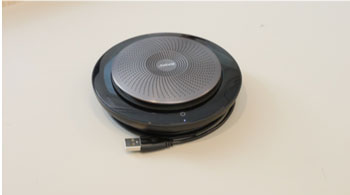Audio and microphones for remote and hybrid activities
This page guides you on how to choose the correct microphone and room for your remote or hybrid activities. You will also get tips on how to get high quality audio when using microphones.
Which microphone should I choose?
Different microphones are suitable for various situations. The microphones that KTH's rooms are equipped with can be divided into close-range microphones and omnidirectional microphones.
Use close-range microphones for individual speakers
Close-range microphones are suitable for individual speakers, such as a lecturer or presenter. They are designed to pick up sound sources located close to the microphone. Properly used they will pick up the speaker's voice with high audio quality. That is, if the microphone is correctly angled and tilted and not positioned too far from the sound source.
Examples of close-range microphones:
- Handheld microphones.
- Lavalier microphone (lapel microphone), small microphones attached to the speaker's clothes or lapel.
- Headsets, such as head microphones attached over the ears.
Reduce the spread of sickness – avoid sharing microphones
Avoid sharing microphones, such as passing around handheld microphones in the room or handing over a headset to the next speaker. Microphones that go from person to person are an unnecessary risk of infection, use several microphones instead.
Another option is that you, as a teacher, repeat the students' questions and comments rather than passing them a microphone.
Omnidirectional microphones are an alternative to close-range microphones.
Use omnidirectional microphones for groups

Omnidirectional microphones pick up sound from a larger area than close-range microphones and are therefore suitable for picking up the voices from several people. As they can be used as a multi-purpose microphone, the teacher does not have to switch between different microphones during longer question times or discussions.
Examples of omnidirectional microphones:
- The ceiling microphones in the hybrid rooms
- Conference microphones, such as the so-called "Jabra puck".
Omnidirectional microphones are sensitive to surrounding sounds
If you use an omnidirectional microphone, inform the students that the microphone is sensitive to surrounding sounds and may pick up other sounds than voices, such as chair rattling and rustling. These sounds might be amplified for the remote participants, even if the participants on site are not disturbed as much.
To reduce annoying and unwanted sounds:
- Close windows and doors.
- Ask room students to turn off their phones, microphones, and speakers.
- Ask the students located on-campus to be as quiet as they can.
Which rooms have which microphones?
At KTH, there are different types of microphones and built-in sound systems depending on the type of room.
The hybrid rooms at KTH are equipped with an omnidirectional ceiling microphone. They are sensitive enough to pick up all voices in the room regardless of distance and you should therefore not have to combine them with other microphones.

In the hybrid rooms, you can also turn off the ceiling microphone via the touch panel for example, if group work is in progress or during breaks.
Lecture halls adapted for hybrid activities are equipped with close-range microphones: one hand-held microphone and a headset that is attached over the ears. They all have the same audio signal, so selecting one in Zoom works for all of them.
If you intend to teach in a classroom, you need to bring a microphone to the room. The document cameras in the classrooms have a built-in microphone (close-range), but as it is attached to the camera. You need to remain seated by it if you want to use it. It is therefore recommended that you bring and use your own microphone instead.
Note: The microphones in the lecture halls and hybrid rooms are connected to the sound system in the room, including the hearing loop. It is therefore recommended to use the rooms microphones instead of bringing your own.
Advice when using audio equipment
When teaching, keep the following in mind:
- Make sure the correct microphone is selected in Zoom, especially if you use multiple microphones or if you have brought your own microphone.
- Make sure the microphone is tilted toward the audio source and is positioned closely to it to get good sound quality.
- Ask students how well they hear you. It is how they perceive the audio that counts.
- Advise remote students to use headsets rather than built-in speakers and microphones.
- Try to stand still when you speak as your footsteps on the floor can be heard.
- Turn off annoying audio sources, such as notifications on your computer and mobile phone.
